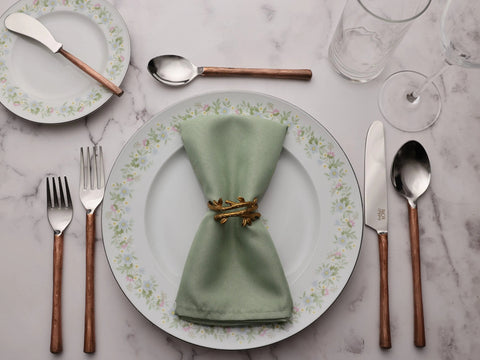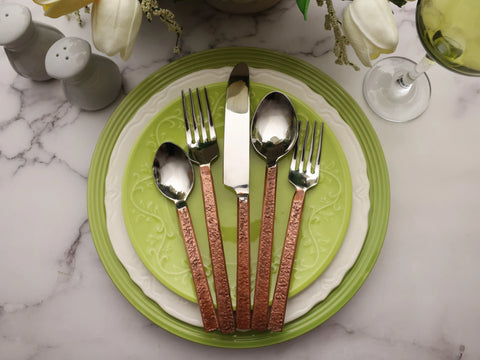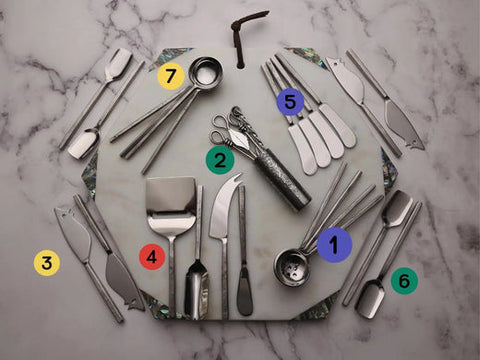“Good manners reflect something from inside – an innate sense of consideration for others and respect for self.” ~ Emily Post
Many of us still consider Emily Post as the queen of etiquette. Her book “Etiquette: The Blue Book of Social Usage” was first published in July 1922, with 19 updated versions since.
The Emily Post Institute was established in 1946. Today, her family runs the institute and continues her legacy by providing a variety of etiquette articles, videos, and online courses on the Emily Post website.
For this blog post, we turn to Emily Post as our guide. We share how to hold and properly use a table fork and knife, how to place a set of butter knives, the proper way to eat bread, and much more.

Jason flatware in nascent steel finish
How to properly use a fork and knife
Did you know that there are different American and Continental (European) styles for holding and using your fork and knife? The styles relate to the way we cut our food and the different ways we hold and use our forks.

The American way
Americans tend to eat with the fork tine facing upwards, like in the above photo. The dominant hand holds the fork when eating.
When it comes to how to use a fork and knife properly when dining, at the core of American style dining, is the fact that the fork and dominant hand are used to eat, while the other hand rests alongside the plate or on your lap.
When it comes to the two styles of eating, the main difference lies in the method of cutting food. For example, when cutting a piece of steak, you would move the fork to your non-dominant hand and your dominant hand cuts the steak. After cutting the meat, the knife is placed across the top of the plate with the sharp end facing inwards, towards the food. Then, you would switch the fork back to your dominant hand to eat the piece of meat. This process is repeated each time you cut any food on your plate.

The proper way to hold a knife when cutting food
Let’s say you’re dining in a restaurant with friends and you remember something that happened early in the week and want to tell the story to your friends. To take a break, you will set your knife across the top of your plate and your fork at the 4 o’clock position on your plate. If you need to leave the table, use the same placement. This lets the servers know you haven’t finished your meal so they won’t remove your plate.

Products used: Camellia flatware with antique copper finish, Sundance cheese accessories (bread knife)
The “close-out position” indicates that you have finished your meal
How do you let the waitperson know you’ve completed your meal? When you are ready to have your plate removed, place your fork at the 4 o’clock position on your plate and move your knife down beside it. This is the “close-out” position.
The Continental way
Used in most countries around the world, the Continental style of dining is easy to learn and use, whether you are right-handed or left-handed. The main difference is the way Continental diners hold their fork.

The Continental way of holding your fork
With this style of eating, there are only two steps to cutting and eating food. Food is cut with the fork in the left hand and knife in the right. After cutting your food, simply bring the fork up to your mouth to take a bite.
How do you place your flatware when taking a break? Lay your fork and knife at a diagonal with the fork tines facing down and crossing over the blade of the knife, like in the photo below.

This is the Continental way of letting the waiter know that you’re taking a break but haven’t finished your meal.

This is the Continental close-out position, indicating that you are finished your meal.
When finished your meal, place the fork with the tines facing downward and the knife together in the 10 and 4 o’clock position. This is similar to the American close-out position except that the fork tines face the plate. We have also seen it done with the knife and fork going straight up and down in the center of the plate, with the handles resting on the rim.
Bread Eating Etiquette
What could be better than warm, freshly baked bread and butter? Bread and butter are two of the most simple but satisfying food combinations that we eat. Whether you’re at a dinner party or a business dinner in a restaurant, there is a correct way to set the dinner table to include bread. But, what may surprise you is that there is a correct way to butter and eat the bread.
So, grab a set of butter knives, and let’s begin by learning where to place the bread plate when setting the table.

The “B and D” method
Whether you’re about to be seated at a crowded banquet table or setting your table for guests, you’ll always know which is your bread plate or where to place your drink (water) glass by remembering the “B and D” trick.

Photo credit: Growinginroom7
Make the letter “b” with your left hand (bread plate goes on the left), and the letter “d” with your right hand (drinks go on the right).

Now that you know how to set your dinner table settings to include a bread plate, you’ll want to take out your favorite set of butter knives and place a butter knife diagonally across each bread plate, with the handle on the right side for easy access.
The correct way to butter and eat your bread
Many people make the mistake of buttering a whole slice of bread and then biting into the slice. This is a surefire way to end up with butter on your fingers and around your mouth!
The proper way is to tear off a bite-sized piece of bread and butter that piece only, right before you put it into your mouth. When you want more bread, tear off another moderate-sized piece, butter it, and enjoy.
If you’re dining in a restaurant that provides individually wrapped squares or mini butter cups, leave the empty wrappings or cups on your bread plate, not on the table.
🍞🧈🍞🧈🍞
Here are some FAQs about our butter knives:
Do the flatware sets for sale on INOX Artisans have matching butter knives?
Yes, many of our flatware styles have matching butter knives available. Many of our customers also enjoy mixing and matching, especially with our collection of rustic copper flatware styles.
How many butter knives are in each set of butter knives?
Each set of butter knives includes 4 handcrafted butter knives.
Why do you call these sets “butter knife/cheese spreader sets”?
Many people, including ourselves, appreciate products that can serve multiple purposes. Who wants utensils that spend weeks tucked away in drawers? We all want products we can use daily. We want products that simplify our lives and offer great value for our money.
Butter knives are versatile, everyday tools for breakfast and lunch. They are perfect for cream cheese on a weekend charcuterie board or for smoothing butter on pancakes and jam on toast during Sunday brunch. Each hand-forged cheese knives set includes a cheese spreader, which is ideal for various spreads, cream cheeses, or for buttering crusty bread.
Are you in the market for a new set of butter knives? We are confident that you will find heirloom quality artisan flatware, butter knives, cheese spreader sets, and other distinctive serving pieces to suit your style and needs.
🧈🧈🧈



